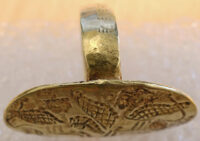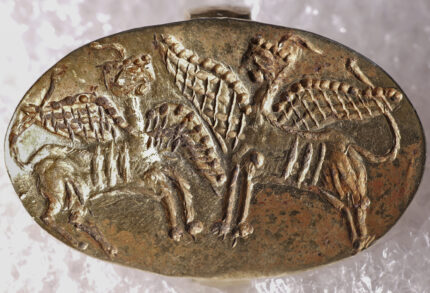A Mycenaean-era gold signet ring has been returned to Greece by the Nobel Foundation in Stockholm, eight decades after it was stolen.
The ring depicts two sphinxes facing each other, tails raised and wings outstretched. It dates to the 3rd millennium B.C. and was found in the grave of a local nobleman in the Mycenaean necropolis in Ialysos, Rhodes, in 1927. At that time, Rhodes was occupied by Italy, an occupation that began before the First World War and only formally ended after the Second (1912-1947; although technically it was a British protectorate for the last two of those years). Italian military authorities directed a program of systematic excavations of numerous ancient sites, including the necropolis. The ring was one of the grave goods recovered from the richly-furnished Tomb 61.
Along with thousands of other artifacts excavated during the Italian occupation, the ring was kept in the collection of the Archaeological Museum of Rhodes. Sometime during World War II, the ring was stolen and disappeared into the penumbra of the private antiquities market. We now know it made its way to the United States in the 1950s or 60s when it was acquired by Hungarian biophysicist Georg von Békésy, winner of the 1961 Nobel Prize in Physiology or Medicine. Békésy died in 1972, leaving his extensive connection of arts and antiquities to the Nobel Foundation. The Foundation spread the works around to various museums in Sweden. The Mycenaean ring went to the Museum of Mediterranean and Eastern Antiquities in Stockholm.
 The ring’s exceptional quality did not go unnoticed. The museum’s director, archaeologist Carl Gustaf Styrenius, recognized the signet ring as one of the treasures of Ialysos and notified the Greek authorities, but for unknown reasons, the rediscovery of the ring slipped through the cracks of Greek bureaucracy into the memory hole.
The ring’s exceptional quality did not go unnoticed. The museum’s director, archaeologist Carl Gustaf Styrenius, recognized the signet ring as one of the treasures of Ialysos and notified the Greek authorities, but for unknown reasons, the rediscovery of the ring slipped through the cracks of Greek bureaucracy into the memory hole.
After so clumsily dropping the ball, Greece was fortunate enough to get a second chance at bat 45 years later. In recent years, the Ministry of Culture has initiated a project to investigate antiquities lost during the Second World War. This time, records of the gold ring were found in the archives and authorities confirmed the Mycenaean signet ring in Stockholm was indeed the one that had disappeared from the Archaeological Museum of Rhodes. The ministry then initiated a formal ownership claim.
In close cooperation with the Ministry of Culture and Sports, the Greek Embassy in Stockholm undertook negotiations with the Museum of Mediterranean and Eastern Antiquities and the Nobel Foundation. The two Swedish institutions welcomed the Greek request from the beginning and willingly provided archival material, as well as any facility for the progress of the negotiations. In this context, the ring was examined by experts from the National Archaeological Museum, who went to Stockholm for this purpose, and its identification with the robbery of Rhodes was confirmed, paving the way for his repatriation.

Sorry, I think it is a “faute de frappe” wben You wrote:
“Békésy died in 1972, leaving his extensive connection of arts and antiquities to the Nobel Foundation.”
You meant ‘collection’ 😇.
WAIT! – Experts from the “National Archaeological Museum”?!? …In Athens?!?
Ialysos is one of the oldest Minoan settlements on Rhodes (near modern Rhodos City). From the 11th century BC onward, however, there where three main cities, Ialysos, Kameiros and Lindos:
Once I had made it all the way up the acropolis in Lindos, there was a nice view from up there, but there also was a small badge: “Dear Wanderer, marvelous things were discovered here, but they are in the National Museum in Ankara“ 😮
———-
Estimated distance: ~1000km (!) –OK, Athens might be least slightly nearer.
Wally, there are also marvelous things from all over the eastern Mediterranian area in the Ottoman Archaeological MUseum in Istanbul. Also, the large bronze doors in the west end of the portico of the Hagia Sophia are from a pagan Greek temple. I don’t recall which one.
Indeed, there really are a lot of Greek temples in Anatolia, George. Actually, I saw those bronze “Emperor Doors” in the ‘Holy Sophie’ in Istanbul myself.
I never made it to Ankara, but I have been to the National Museum in Athens and also to the great Archeological Museum in Rhodos City.
In 386AD, the pagan Libanios from -I think- Syria wrote his impressive “complaint letter” about Christians to the (Christian) Emperor Theodosios in what is now Istanbul.
:hattip:
——————————–
“…Those black-garbed people eat more than elephants and demand a large quantity of liquor from the people who send them drink for their chantings, but who hide their luxury by their pale artificial countenances,—-These men, O Emperor, even whilst your law is in force, run to the temples, bringing with them wood, and stones, and iron, and when they have not these, hands and feet. Then follows a Mysian prey, the roofs are uncovered, walls are pulled down, images are carried off, and altars are overturned: Our priests must be silent upon pain of death. When they have destroyed one temple they run to another, and a third, and trophies are erected upon trophies: which are all contrary to the law. …” (Libanios 30, “Προς Θεοδόσιον τον βασιλέα υπέρ των ιερών”, –For the Temples!)
——————————-